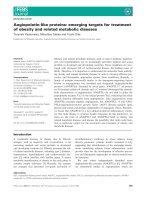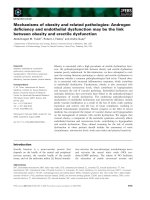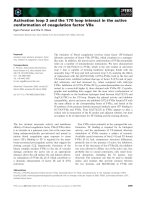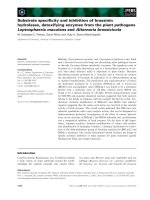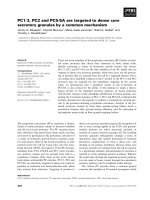Báo cáo khoa học: "Sinhala Grapheme-to-Phoneme Conversion and Rules for Schwa Epenthesis" potx
Bạn đang xem bản rút gọn của tài liệu. Xem và tải ngay bản đầy đủ của tài liệu tại đây (271.04 KB, 8 trang )
Proceedings of the COLING/ACL 2006 Main Conference Poster Sessions, pages 890–897,
Sydney, July 2006.
c
2006 Association for Computational Linguistics
Sinhala Grapheme-to-Phoneme Conversion and
Rules for Schwa Epenthesis
Asanka Wasala, Ruvan Weerasinghe and Kumudu Gamage
Language Technology Research Laboratory
University of Colombo School of Computing
35, Reid Avenue, Colombo 07, Sri Lanka
{awasala,kgamage}@webmail.cmb.ac.lk,
Abstract
This paper describes an architecture to
convert Sinhala Unicode text into pho-
nemic specification of pronunciation. The
study was mainly focused on disambigu-
ating schwa-/\/ and /a/ vowel epenthesis
for consonants, which is one of the sig-
nificant problems found in Sinhala. This
problem has been addressed by formulat-
ing a set of rules. The proposed set of
rules was tested using 30,000 distinct
words obtained from a corpus and com-
pared with the same words manually
transcribed to phonemes by an expert.
The Grapheme-to-Phoneme (G2P) con-
version model achieves 98 % accuracy.
1 Introduction
The conversion of Text-to-Speech (TTS) in-
volves many important processes. These proc-
esses can be divided mainly in to three parts; text
analysis, linguistic analysis and waveform gen-
eration (Black and Lenzo, 2003). The text analy-
sis process is responsible for converting the non-
textual content into text. This process also in-
volves tokenization and normalization of the
text. The identification of words or chunks of
text is called text-tokenization. Text normaliza-
tion establishes the correct interpretation of the
input text by expanding the abbreviations and
acronyms. This is done by replacing the non-
alphabetic characters, numbers, and punctuation
with appropriate text strings depending on the
context. The linguistic analysis process involves
finding the correct pronunciation of words, and
assigning prosodic features (eg. phrasing, intona-
tion, stress) to the phonemic string to be spoken.
The final process of a TTS system is waveform
generation which involves the production of an
acoustic digital signal using a particular synthesis
approach such as formant synthesis, articulatory
synthesis or waveform concatenation (Lemmetty,
1999). The text analysis and linguistic analysis
processes together are known as the Natural
Language Processing (NLP) component, while
the waveform generation process is known as the
Digital Signal Processing (DSP) component of a
TTS System (Dutoit, 1997).
Finding correct pronunciation for a given
word is one of the first and most significant tasks
in the linguistic analysis process. The component
which is responsible for this task in a TTS sys-
tem is often named the Grapheme-To-Phoneme
(G2P), Text-to-Phone or Letter-To-Sound (LTS)
conversion module. This module accepts a word
and generates the corresponding phonemic tran-
scription. Further, this phonemic transcription
can be annotated with appropriate prosodic
markers (Syllables, Accents, Stress etc) as well.
In this paper, we describe the implementation
and evaluation of a G2P conversion model for a
Sinhala TTS system. A Sinhala TTS system is
being developed based on Festival, the open
source speech synthesis framework. Letter to
sound conversion for Sinhala usually has simple
one to one mapping between orthography and
phonemic transcription for most Sinhala letters.
However some G2P conversion rules are pro-
posed in this paper to complement the generation
of more accurate phonemic transcription.
The rest of this paper is organized as follows:
Section 2 gives an overview of the Sinhala pho-
nemic inventory and the Sinhala writing system,
Section 3 briefly discusses G2P conversion ap-
proaches. Section 4 describes the schwa epenthe-
sis issue peculiar to Sinhala and Section 5 ex-
plains the Sinhala G2P conversion architecture.
890
Section 6 gives experimental results and our dis-
cussion on it. The work is summarized in the
final section.
2 Sinhala Phonemic Inventory and
Writing System
2.1 The Sinhala Phonemic Inventory
Sinhala is the official language of Sri Lanka and
the mother tongue of the majority - 74% of its
population. Spoken Sinhala contains 40 segmen-
tal phonemes; 14 vowels and 26 consonants as
classified below in Table 1 and Table 2 (Ka-
runatillake, 2004).
There are two nasalized vowels occurring in
two or three words in Sinhala. They are /a~/, /a~:/,
/æ~/ and /æ~~:/ (Karunatillake, 2004). Spoken Sin-
hala also has following Diphthongs; /iu/, /eu/,
/æu/, /ou/, /au/, /ui/, /ei/, /æi/, /oi/ and /ai/
(Disanayaka, 1991).
Front Central Back
Short Long Short Long Short Long
High
i i: u u:
Mid
e e: \ \: o o:
Low
æ æ: a a:
Table 1. Spoken Sinhala Vowel Classification.
Lab.Den. Alv.Ret.Pal. Vel.Glo.
Voiceless
p t ˇ k
Stops
Voiced
b d Î ˝
Voiceless
c
Affricates
Voiced
Ô
Pre-nasalized
voiced stops
b~ d~
Î~ ˝~
N
asals
m
n μ ˜
Trill
r
Lateral
l
Spirants
f s
ß h
Semivowels
w j
Table 2
*
. Spoken Sinhala Consonant
Classification.
A separate sign for vowel /\/ is not provided by
the Sinhala writing system. In terms of distribu-
tion, the vowel /\/ does not occur at the begin-
ning of a syllable except in the conjugational
variants of verbs formed from the verbal stem
/k\r\/ (to do). In contrast to this, though the letter
*
Lab. – Labial, Den. – Dental, Alv. – Alveolar, Ret. –
Retroflex, Pal. – Palatal, Vel. – Velar and Glo. – Glottal.
“”, which symbolizes the consonant sound /Ô~/
exists, it is not considered a phoneme in Sinhala.
2.2 The Sinhala Writing System
The Sinhala character set has 18 vowels, and 42
consonants as shown in Table 3.
Vowels and corresponding vowel modifiers
(within brackets):
() () () (
) (
) () (
) (
)
() () () () (
) ()
() () ()
Consonants:
Special symbols:
Inherent vowel remover (Hal marker):
Table 3. Sinhala Character Set.
Sinhala characters are written left to right in
horizontal lines. Words are delimited by a space
in general. Vowels have corresponding full-
character forms when they appear in an absolute
initial position of a word. In other positions, they
appear as ‘strokes’ and, are used with consonants
to denote vowel modifiers. All vowels except
“” /iru:/, are able to occur in word initial posi-
tions (Disanayaka, 1995). The vowel /ə/ and /ə:/
occurs only in loan words of English origin.
Since there are no special symbols to represent
them, frequently the “” vowel is used to sym-
bolize them (Karunatillake, 2004).
All consonants occur in word initial position
except /ŋ/ and nasals (Disanayaka, 1995). The
symbols “”, and “” represent the retroflex
nasal /¯/ and the retroflex lateral /Æ/ respectively.
But they are pronounced as their respective
alveolar counterparts “”-/n/ and “”-/l/.
Similarly, the symbol “” representing the
retroflex sibilant /Í/, is pronounced as the palatal
sibilant “”-/ß/. The corresponding aspirated
symbols of letters , , , , , , , , ,
namely , , , , , , , , respectively
are pronounced like the corresponding un-
aspirates (Karunatillake, 2004). When conso-
nants are combined with /r/ or /j/, special con-
junct symbols are used. “
”-/r/ immediately fol-
lowing a consonant can be marked by the symbol
“
” added to the bottom of the consonant preced-
ing it. Similarly, “”-/j/, immediately following
consonant can be marked by the symbol “
”
891
added to the right-hand side of the consonant
preceding it (Karunatillake, 2004). “
” /ilu/ and
“
” /ilu:/ do not occur in contemporary Sinhala
(Disanayaka, 1995). Though there are 60 sym-
bols in Sinhala (Disanayaka, 1995), only 42
symbols are necessary to represent Spoken Sin-
hala (Karunatillake, 2004).
3 G2P Conversion Approaches
The issue of mapping textual content into pho-
nemic content is highly language dependent.
Three main approaches of G2P conversion are;
use of a pronunciation dictionary, use of well
defined language-dependent rules and data-
driven methods (El-Imam and Don, 2005).
One of the easiest ways of G2P conversion is
the use of a lexicon or pronunciation dictionary.
A lexicon consists of a large list of words to-
gether with their pronunciation. There are several
limitations to the use of lexicons. It is practically
impossible to construct such to cover the whole
vocabulary of a language owing to Zipfian phe-
nomena. Though a large lexicon is constructed,
one would face other limitations such as efficient
access, memory storage etc. Most lexicons often
do not include many proper names, and only
very few provide pronunciations for abbrevia-
tions and acronyms. Only a few lexicons provide
distinct entries for morphological productions of
words. In addition, pronunciations of some
words differ based on the context and their parts-
of-speech. Further, an enormous effort has to be
made to develop a comprehensive lexicon. In
practical scenarios, speech synthesizers as well
as speech recognizers need to be able to produce
the pronunciation of words that are not in the
lexicon. Names, morphological productivity and
numbers are the three most important cases that
cause the use of lexica to be impractical (Juraf-
sky and Martin, 2000).
To overcome these difficulties, rules can be
specified on how letters can be mapped to pho-
nemes. In this way, the size of the lexicon can be
reduced as only to contain exceptions to the
rules. In contrast to the above fact, some systems
rely on using very large lexicons, together with a
set of letter-to-sound conversion rules to deal
with words which are not found in the lexicon
(Black and Lenzo, 2003).
These language and context dependent rules
are formulated using phonetic and linguistic
knowledge of a particular language. The com-
plexity of devising a set of rules for a particular
language is dependent on the degree of corre-
spondence between graphemes and phonemes.
For some languages such as English and French,
the relationship is complex and require large
numbers of rules (El-Imam and Don, 2005;
Damper et al., 1998), while some languages such
as Urdu (Hussain, 2004), and Hindi (Ramakish-
nan et al., 2004; Choudhury, 2003) show regular
behavior and thus pronunciation can be modeled
by defining fairly regular simple rules.
Data-driven methods are widely used to avoid
tedious manual work involving the above ap-
proaches. In these methods, G2P rules are cap-
tured by means of various machine learning
techniques based on a large amount of training
data. Most previous data-driven approaches have
been used for English. Widely used data-driven
approaches include, Pronunciation by Analogy
(PbA), Neural Networks (Damper et al., 1998),
and Finite-State-Machines (Jurafsky and Martin,
2000). Black et al. (1998) discussed a method for
building general letter-to-sound rules suitable for
any language, based on training a CART – deci-
sion tree.
4 Schwa Epenthesis in Sinhala
G2P conversion problems encountered in Sinhala
are similar to those encountered in the Hindi lan-
guage (Ramakishnan et al., 2004). All consonant
graphemes in Sinhala are associated with an in-
herent vowel schwa-/ə/ or /a/ which is not repre-
sented in orthography. Vowels other than /ə/ and
/a/ are represented in orthographic text by plac-
ing specific vowel modifier diacritics around the
consonant grapheme. In the absence of any
vowel modifier for a particular consonant graph-
eme, there is an ambiguity of associating /ə/ or
/a/ as the vowel modifier. The inherent vowel
association in Sinhala can be distinguished from
Hindi. In Hindi the only possible association is
schwa vowel where as in Sinhala either of
vowel-/a/ or schwa-/ə/ can be associated with a
consonant. Native Sinhala speakers are naturally
capable of choosing the association of the appro-
priate vowel (/ə/ or /a/) in context. Moreover,
linguistic rules describing the transformation of
G2P, is rarely found in literature, with available
literature not providing any precise procedure
suitable for G2P conversion of contemporary
Sinhala. Automating the G2P conversion process
is a difficult task due to the ambiguity of choos-
ing between /ə/ and /a/.
A similar phenomenon is observed in Hindi
and Malay as well. In Hindi, the “deletion of the
schwa vowel (in some cases)” is successfully
892
solved by using rule based algorithms (Choud-
hury 2003; Ramakishnan et al., 2004). In Malay,
the character ‘e’ can be pronounced as either
vowel /e/ or /ə/, and rule based algorithms are
used to address this ambiguity (El-Imam and
Don, 2005).
In our research, a set of rules is proposed to
disambiguate epenthesis of /a/ and /ə/, when as-
sociating with consonants. Unlike in Hindi, in
Sinhala, the schwa is not deleted, instead always
inserted. Hence, this process is named “Schwa
Epenthesis” in this paper.
5 Sinhala G2P Conversion Architecture
An architecture is proposed to convert Sinhala
Unicode text into phonemes encompassing a set
of rules to handle schwa epenthesis. The G2P
architecture developed for Sinhala is identical to
the Hindi G2P architecture (Ramakishnan et al.,
2004). The input to the system is normalized
Sinhala Unicode text. The G2P engine first maps
all characters in the input word into correspond-
ing phonemes by using the letter-to-phoneme
mapping table below (Table 4).
/a/
,
/o/
/Î~/
/f/
,
/a:/
,
/o:/
,
/t/
/ru:/
,
/æ/
,
/ou/
,
/d/
,
/æ:/
,
/k/
/d~/
,
/i/
,
/˝/
,
/p/
,
/i:/
,
/˜/
,
/b/
,
/u/
/˝~/
/m/
.
/u:/
,
/c/
/b~/
/ri/
,
/Ô/
/j/
/ru/
/μ/
/r/
/ilu/
/jμ/
,
/l/
/ilu:/
/Ô~/
/w/
,
/e/
,
/ˇ/
,
/ß/
,
/e:/
,
/Î/
/s/
,
/ai/
,
/n/
,
/h/
Table 4. G2P Mapping Table
The mapping procedure is given in section 5.1.
Then, a set of rules are applied to this phonemic
string in a specific order to obtain a more accu-
rate version. This phonemic string is then com-
pared with the entries in the exception lexicon. If
a matching entry is found, the correct pronuncia-
tion form of the text is obtained from the lexicon,
otherwise the resultant phonemic string is re-
turned. Hence, the final output of G2P model is
the phonemic transcription of the input text.
5.1 G2P Mapping Procedure
Each tokenized word represented by Unicode
normalization form is analyzed by individual
graphemes from left to right. By using the G2P
mapping table (Table 4), corresponding pho-
nemes are obtained. As in the given example
Figure 1, no mappings are required for the Zero-
Width-Joiner and diacritic Hal marker “
” (Ha-
lant) which is used to remove the inherent vowel
in a consonant.
Figure 1. G2P Mapping (Example).
The next step is epenthesis of schwa-/ə/ for
consonants. In Sinhala, the tendency of associat-
ing a /ə/ with consonant is very much higher than
associating vowel /a/. Therefore, initially, all
plausible consonants are associated with /ə/. To
obtain the accurate pronunciation, the assigned
/ə/ is altered to /a/ or vice versa by applying the
set of rules given in next section. However, when
associating /ə/ with consonants, /ə/ should asso-
ciate only with consonant graphemes excluding
the graphemes “”, “” and “”, which do not
contain any vowel modifier or diacritic Hal
marker. In the above example, only /n/ and first
/j/ are associated with schwa, because other con-
sonants violate the above principle. When schwa
is associated with appropriate consonants, the
resultant phonemic string for the given example
(section 5.1) is; /nəmjəji/.
5.2 G2P Conversion Rules
It is observed that resultant phoneme strings
from the above procedure should undergo several
modifications in terms of schwa assignments into
vowel /a/ or vice versa, in order to obtain the ac-
curate pronunciation of a particular word.
Guided by the literature (Karunatillake, 2004), it
was noticed that these modifications can be car-
ried out by formulating a set of rules.
The G2P rules were formulated with the aid of
phonological rules described in the linguistic
literature (Karunatillake, 2004) and by a com-
prehensive word search analysis using the UCSC
893
Sinhala corpus BETA (2005). Some of these ex-
isting phonological rules were altered in order to
reflect the observations made in the corpus word
analysis and to achieve more accurate results.
The proposed new set of rules is empirically
shown to be effective and can be conveniently
implemented using regular expressions.
Each rule given below is applied from left to
right, and the presented order of the rules is to be
preserved. Except for rule #1, rule #5, rule #6
and rule #8, all other rules are applied repeatedly
many times to a single word until the conditions
presented in the rules are satisfied.
Rule #1: If the nucleus of the first syllable is a
schwa, the schwa should be replaced by vowel
/a/ (Karunatillake, 2004), except in the following
situations;
(a) The syllable starts with /s/ followed by /v/.
(ie. /sv/)
(b) The first syllable starts with /k/ where as,
/k/ is followed by /ə/ and subsequently /ə/ is pre-
ceded by /r/. (ie. /kər/)
(c) The word consists of a single syllable having
CV structure (eg. /də/)
Rule #2:
(a) If /r/ is preceded by any consonant, followed
by /ə/ and subsequently followed by /h/, then /ə/
should be replaced by /a/.
(/[consonant]rəh/->/[consonant]rah/ )
(b) If /r/ is preceded by any consonant, followed
by /ə/ and subsequently followed by any conso-
nant other than /h/, then /ə/ should be replaced by
/a/.
(/[consonant]rə[!h]/->/[consonant]ra[!h]/ )
(c) If /r/ is preceded by any consonant, followed
by /a/ and subsequently followed by any conso-
nant other than /h/, then /a/ should be replaced by
/ə/.
(/[consonant]ra[!h]/->/[consonant]rə!h]/)
(d) If /r/ is preceded by any consonant, followed
by /a/ and subsequently followed by /h/, then /a/
is retained.
(/[consonant]ra[h]/->/[consonant]ra[h]/)
Rule #3: If any vowel in the set {/a/, /e/, /æ/, /o/,
/\/} is followed by /h/ and subsequently /h/ is
preceded by schwa, then schwa should replaced
by vowel /a/.
Rule #4: If schwa is followed by a consonant
cluster, the schwa should be replaced by /a/ (Ka-
runatillake, 2004).
Rule #5: If /ə/ is followed by the word final con-
sonant, it should be replaced by /a/, except in the
situations where the word final consonant is /r/,
/b/, /Î/ or /ˇ/.
Rule #6: At the end of a word, if schwa precedes
the phoneme sequence /ji/, the schwa should be
replaced by /a/ (Karunatillake, 2004).
Rule #7: If the /k/ is followed by schwa, and
subsequent phonemes are /r/ or /l/ followed by
/u/, then schwa should be replaced by phoneme
/a/. (ie. /kə(r|l)u/->/ka(r|l)u/)
Rule #8: Within the given context of following
words, /a/ found in phoneme sequence /kal/, (the
left hand side of the arrow) should be changed to
/ə/ as shown in the right hand side.
• /kal(a:|e:|o:)y/->/kəl(a:|e:|o:)y/
• /kale(m|h)(u|i)/->/kəle(m|h)(u|i)/
• /kaləh(u|i)/->/kəleh(u|i)/
• /kalə/->/kələ/
The above rules handle the schwa epenthesis
problem. The corresponding diphthongs (refer
section 2) are then obtained by processing the
resultant phonetized string. This string is again
analyzed from left to right, and the phoneme se-
quences given in the first column of Table 5 are
replaced by the diphthong, represented in the
second column.
Phoneme Sequence Diphthong
/i/ /w/ /u/ /iu/
/e/ /w/ /u/ /eu/
/æ/ /w/ /u/ /æu/
/o/ /w/ /u/ /ou/
/a/ /w/ /u/ /au/
/u/ /j/ /i/ /ui/
/e/ /j/ /i/ /ei/
/æ/ /j/ /i/ /æi/
/o/ /j/ /i/ /oi/
/a/ /j/ /i/ /ai/
Table 5. Diphthong Mapping Table.
The application of the above rules for the
given example (section 5.1) is illustrated in Fig-
ure 2.
Figure 2. Application of G2P Rules – An Exam-
ple.
894
6 Results and Discussion
Text obtained from the category “News Paper>
Feature Articles > Other” of the UCSC Sinhala
corpus was chosen for testing due to the hetero-
geneous nature of these texts and hence per-
ceived better representation of the language in
this part of the corpus
*
. A list of distinct words
was first extracted, and the 30,000 most fre-
quently occurring words chosen for testing.
The overall accuracy of our G2P module was
calculated at 98%, in comparison with the same
words correctly transcribed by an expert.
Since this is the first known documented work
on implementing a G2P scheme for Sinhala, its
contribution to the existing body of knowledge is
difficult to evaluate. However, an experiment
was conducted in order to arrive at an approxi-
mation of the scale of this contribution.
It was first necessary, to define a baseline
against which this work could be measured.
While this could be done by giving a single de-
fault letter-to-sound mapping for any Sinhala
letter, owing to the near universal application of
rule #1 in Sinhala words (22766 of the 30000
words used in testing), the baseline was defined
by the application of this rule in addition to the
‘default mapping’. This baseline gives us an er-
ror of approximately 24%. Since the proposed
solution reduces this error to 2%, this work can
claim to have improved performance by 22%.
An error analysis revealed the following types
of errors (Table 6):
Error description # of
words
Compound words- (ie. Single words
formed by combining 2 or more distinct
words; such as in the case of the English
word “thereafter”).
382
Foreign (mainly English) words directly
encoded in Sinhala. eg.
- fashion,
- campus.
116
Other 118
Table 6. Types of Errors.
The errors categorized as “Other” are given
below with clarifications:
• The modifier used to denote long vowel
“” /a:/ is “” which is known as “Aela-
pilla”. eg. consonant “” /k/ associates
with “” /a:/ to produce grapheme “” is
pronounced as /ka:/. The above exercise
*
This accounts for almost two-thirds of the size of this ver-
sion of the corpus.
revealed some 37 words end without
vowel modifier “”, but are usually pro-
nounced with the associated long vowel
/a:/. In the following examples, each input
word is listed first, followed by the erro-
neous output of G2P conversion, and cor-
rect transcription.
“
”(mother) -> /ammə/ -> /amma:/
“
”(sister) -> /akkə/ -> /akka:/
“
”(taken)-> /gattə/ -> /gatta:/
• There were 27 words associated with er-
roneous conversion of words having the
letter “”, which corresponds to phoneme
/h/. The study revealed this letter shows an
unusual behavior in G2P conversion.
• The modifier used to denote vowel “”
- “” is known as “Geta-pilla”. When
this vowel appears as the initial letter of a
word, it is pronounced as /ri/ as in “”
/rinə/ (minus). When the corresponding
vowel modifier appears in a middle of a
word most of the time it is pronounced as
/ru/ (Disanayaka, 2000). eg. “”
(book)is pronounced as /krutijə/, “”
(surface) - /pruߡ\j\/, “” (excel-
lent)-/utkruߡ\/. But 13 words were found
as exceptions of this general rule. In those
words, the “” is pronounced as /ur/
rather than /ru/. eg. “” (news)-
/prəwurti/,“”(prosperity)-/samurdi/,
“” (opened) - /wiwurtə/.
• In general, vowel modifiers “” (Adha-
pilla), “” (Diga Adha-pilla) symbolizes
the vowel “” /æ/ and “” /æ:/ respec-
tively. eg. consonant “
” /k/ combines
with vowel modifier “” to create “”
which is pronounced as /kæ/. Few words
were found where this rule is violated. In
such words, the vowel modifiers “” and
“” represent vowels “”- /u/, and “”-
/u:/ respectively. eg. “” (legend) -
/Ôanəßruti/, “” (cruel) - /kru:r\/.
• The verbal stem “” (to do) is pro-
nounced as /kərə/. Though there are many
words starting with the same verbal stem,
there are a few other words differently
pronounced as /karə/ or /kara/. eg.
“” (cart) /karattəyə/, “”
(dried fish) /karəvələ/.
895
• A few of the remaining errors are due to
homographs; “” - /vanə/, /vənə/; “”
-/kalə/, /kələ/; “” - /karə/, /kərə/.
The above error analysis itself shows that the
model can be extended. Failures in the current
model are mostly due to compound words and
foreign words directly encoded in Sinhala
(1.66%). The accuracy of the G2P model can be
increased significantly by incorporating a
method to identify compound words and tran-
scribe them accurately. If the constituent words
of a compound word can be identified and sepa-
rated, the same set of rules can be applied for
each constituent word, and the resultant pho-
netized strings combined to obtain the correct
pronunciation. The same problem is observed in
the Hindi language too. Ramakishnan et al.
(2004) proposed a procedure for extracting com-
pound words from a Hindi corpus. The utiliza-
tion of compound word lexicon in their rule-
based G2P conversion module improved the ac-
curacy of G2P conversion by 1.6% (Ramakish-
nan et al., 2004). In our architecture, the most
frequently occurring compound words and for-
eign words are dealt with the aid of an excep-
tions lexicon. Homographs are also disambigu-
ated using the most frequently occurring words
in Sinhala. Future improvements of the architec-
ture will include incorporation of a compound
word identification and phonetization module.
7 Conclusion
In this paper, the problem of Sinhala grapheme-
to-phoneme conversion is addressed with a spe-
cial focus on dealing with the schwa epenthesis.
The proposed G2P conversion mechanism will
be useful in various applications in the speech
domain. To the best of our knowledge no other
documented evidence has been reported for Sin-
hala grapheme-to-phoneme conversion in the
literature. There are no other approaches avail-
able for the transcription of Sinhala text that pro-
vides a platform for comparison of the proposed
rule-based method. The empirical evidence from
a wide spectrum Sinhala corpus indicates that the
proposed model can account for nearly 98% of
cases accurately.
The proposed G2P module is fully imple-
mented in Sinhala TTS being developed at Lan-
guage Technology Research Lab, UCSC. A
demonstration tool of the proposed G2P module
integrated with Sinhala syllabification algorithm
proposed by Weerasinghe et al. (2005) is avail-
able for download from:
Acknowledgement
This work has been supported through the PAN
Localization Project, ()
grant from the International Development Re-
search Center (IDRC), Ottawa, Canada, adminis-
tered through the Center for Research in Urdu
Language Processing, National University of
Computer and Emerging Sciences, Pakistan. The
authors would like to thank Sinhala Language
scholars Prof. R.M.W. Rajapaksha, and Prof. J.B.
Dissanayake for their invaluable support and ad-
vice throughout the study. Special thanks to Dr.
Sarmad Hussain (NUCES, Pakistan) for his
guidance and advices. We also wish to acknowl-
edge the contribution of Mr. Viraj Welgama, Mr.
Dulip Herath, and Mr. Nishantha Medagoda of
Language Technology Research Laboratory of
the University of Colombo School of Comput-
ing, Sri Lanka.
References
Alan W. Black and Kevin A. Lenzo. 2003. Building
Synthetic Voices
, Language Technologies Insti-
tute, Carnegie Mellon University and Cepstral
LLC. Retrieved from
Alan W. Black, Kevin Lenzo, and Vincent Pagel.
1998. Issues in Building General Letter to Sound
Rules.
In Proc. of the 3rd ESCA Workshop on
Speech Synthesis
, pages 77–80.
Monojit Choudhury. 2003. Rule-Based Grapheme to
Phoneme Mapping for Hindi Speech Synthesis,
presented at the 90th Indian Science Congress
of the International Speech Communication
Association (ISCA)
, Bangalore.
R.I. Damper, Y. Marchand, M.J. Adamson and K.
Gustafson. 1998. Comparative Evaluation of Let-
ter-to-Sound Conversion Techniques for English
Text-to-Speech Synthesis. In Proc. Third
ESCA/COCOSDA Workshop on Speech Syn-
thesis
, pages 53- 58, Blue Mountains, NSW, Aus-
tralia.
J.B. Disanayaka. 1991.
The Structure of Spoken
Sinhala
, National Institute of Education, Ma-
haragama.
J.B. Disanayaka. 2000.
Basaka Mahima: 2, Akuru
ha pili
, S. Godage & Bros., 661, P. D. S.
Kularathna Mawatha, Colombo 10.
J.B. Disanayaka. 1995.
Grammar of Contemporary
Literary Sinhala - Introduction to Grammar,
896
Structure of Spoken Sinhala, S. Godage & Bros.,
661, P. D. S. Kularathna Mawatha, Colombo 10.
T. Dutoit. 1997.
An Introduction to Text-to-
Speech Synthesis,
Kluwer Academic Publishers,
Dordrecht, Netherlands.
Yousif A. El-Imam and Zuraidah M. Don. 2005.
Rules and Algorithms for Phonetic Transcription of
Standard Malay,
IEICE Trans Inf & Syst, E88-D
2354-2372.
Sarmad Hussain. 2004. Letter-to-Sound Conversion
for Urdu Text-to-Speech System,
Proceedings of
Workshop on "Computational Approaches to
Arabic Script-based Languages,"
COLING
2004,
p. 74-49, Geneva, Switzerland.
Daniel Jurafsky and James H. Martin. 2000.
Speech
and Language Processing: An Introduction to
Natural Language Processing, Computational
Linguistics, and Speech Recognition
. Pearson
Education (Singapore) Pte. Ltd, Indian Branch, 482
F.I.E. Patparganj, Delhi 110 092, India.
W.S. Karunatillake. 2004.
An Introduction to Spo-
ken Sinhala
, 3
rd
edn., M.D. Gunasena & Co. ltd.,
217, Olcott Mawatha, Colombo 11.
Sami Lemmetty. 1999.
Review of Speech Synthesis
Technology
, MSc. thesis, Helsinki University of
Technology.
A.G. Ramakishnan, Kalika Bali, Partha Pratim Taluk-
dar N. and Sridhar Krishna. 2004. Tools for the
Development of a Hindi Speech Synthesis System,
In 5th ISCA Speech Synthesis Workshop, Pitts-
burgh. pages 109-114.
Ruvan Weerasinghe, Asanka Wasala and Kumudu
Gamage. 2005. A Rule Based Syllabification Algo-
rithm for Sinhala,
Proceedings of 2
nd
Interna-
tional Joint Conference on Natural Language
Processing (IJCNLP-05)
, p. 438-449, Jeju Is-
land, Korea.
UCSC Sinhala Corpus BETA. 2005. Retrieved Au-
gust 30, 2005, from University of Colombo School
of Computing, Language Technology Research
Laboratory Web site:
897

